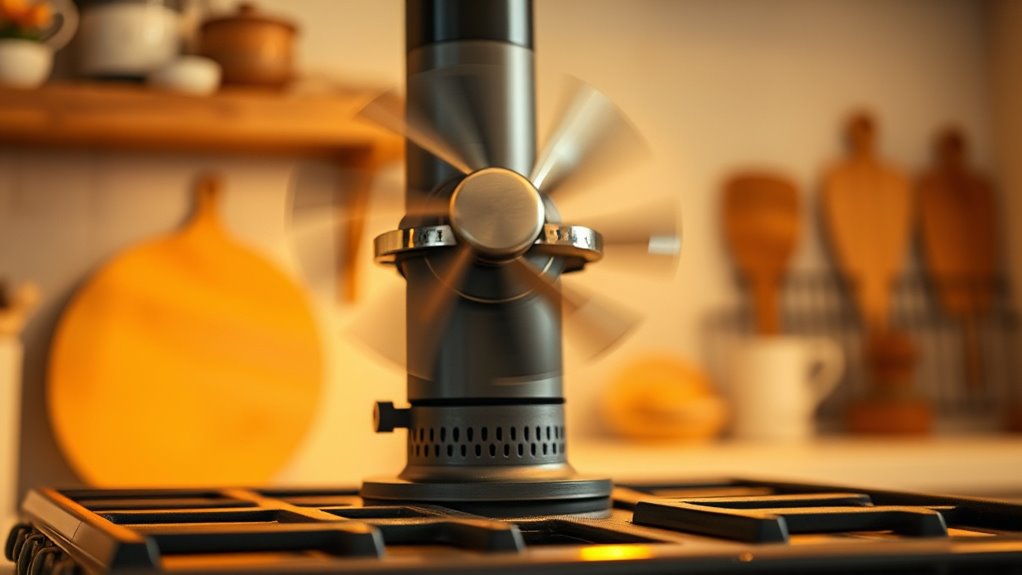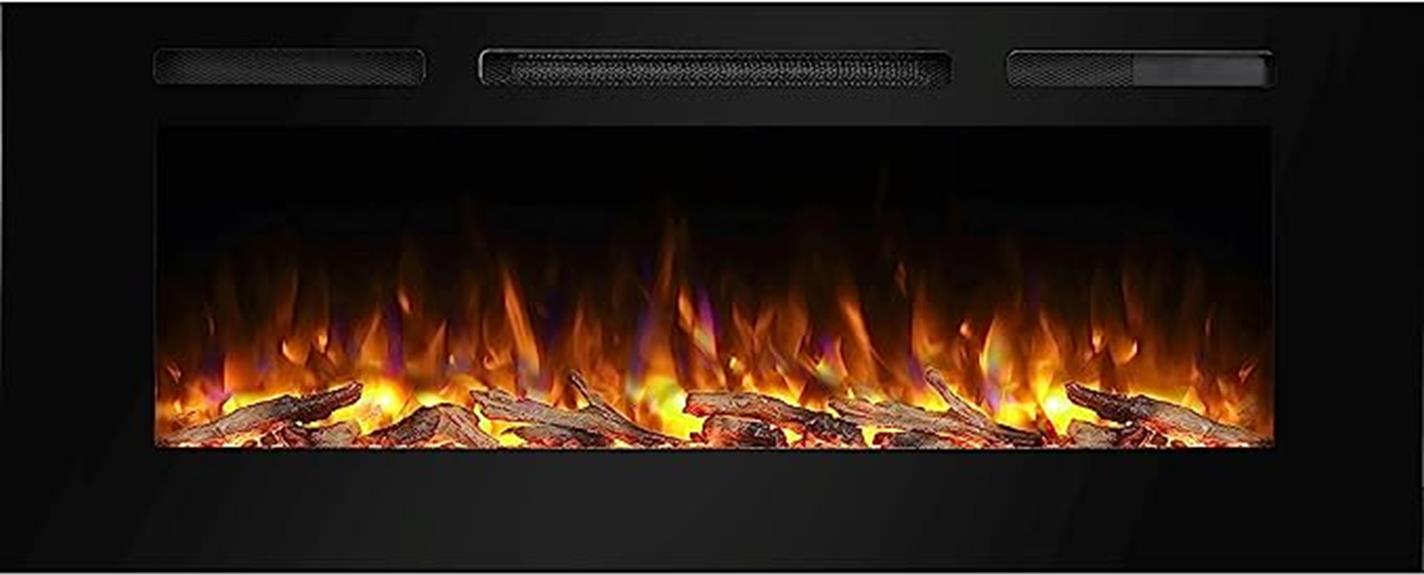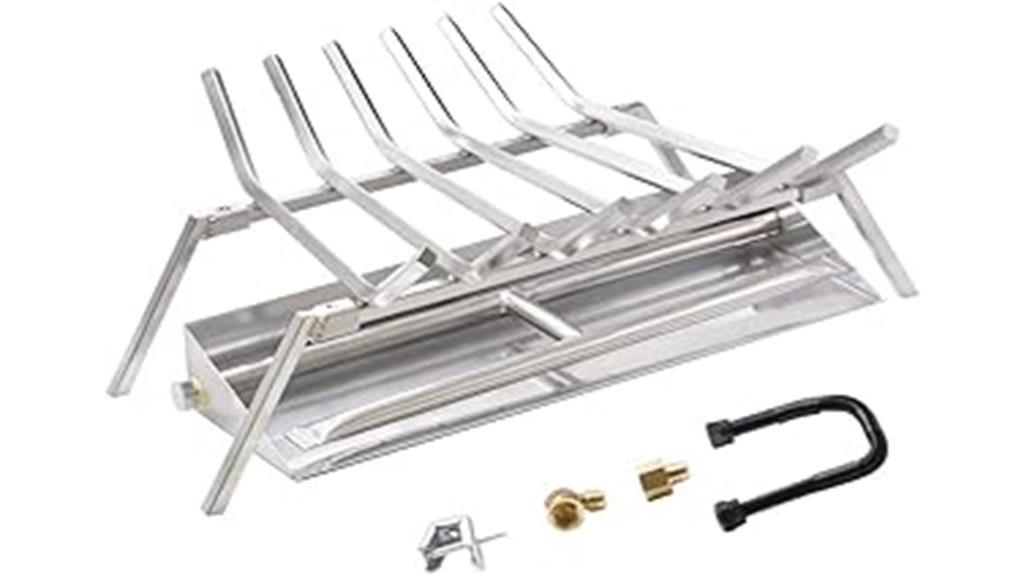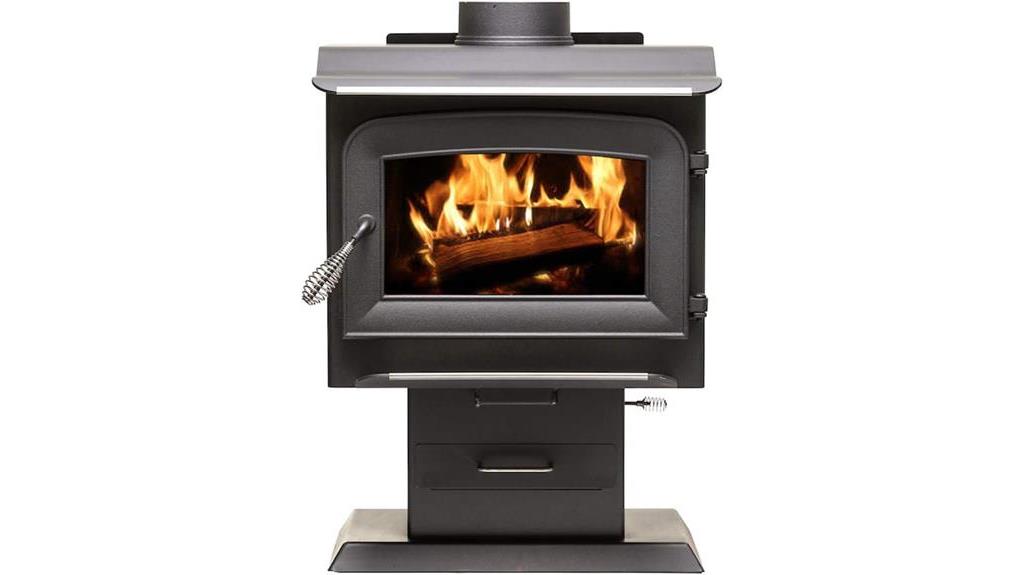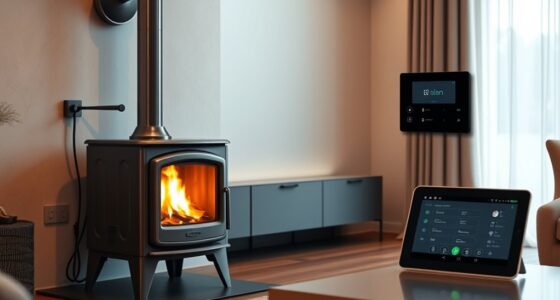Stove fans help distribute heat evenly by converting the stove’s warmth into electricity through thermoelectric modules. These modules create a temperature difference, powering a fan that actively circulates warm air across the room. This improves comfort and reduces cold spots, making your heating more efficient. Proper placement and operation ensure ideal performance, but they don’t make your stove more efficient themselves. Keep exploring to understand how to maximize their benefits effectively.
Key Takeaways
- Stove fans enhance heat distribution by circulating warm air evenly throughout the room.
- They increase airflow, creating convective currents that reduce hot and cold spots.
- The fans are powered by electricity generated from heat via thermoelectric modules.
- Proper placement and operation optimize heat circulation and room comfort.
- They improve heating efficiency without increasing fuel consumption by better distributing existing heat.
How Stove Fans Convert Heat Into Electricity
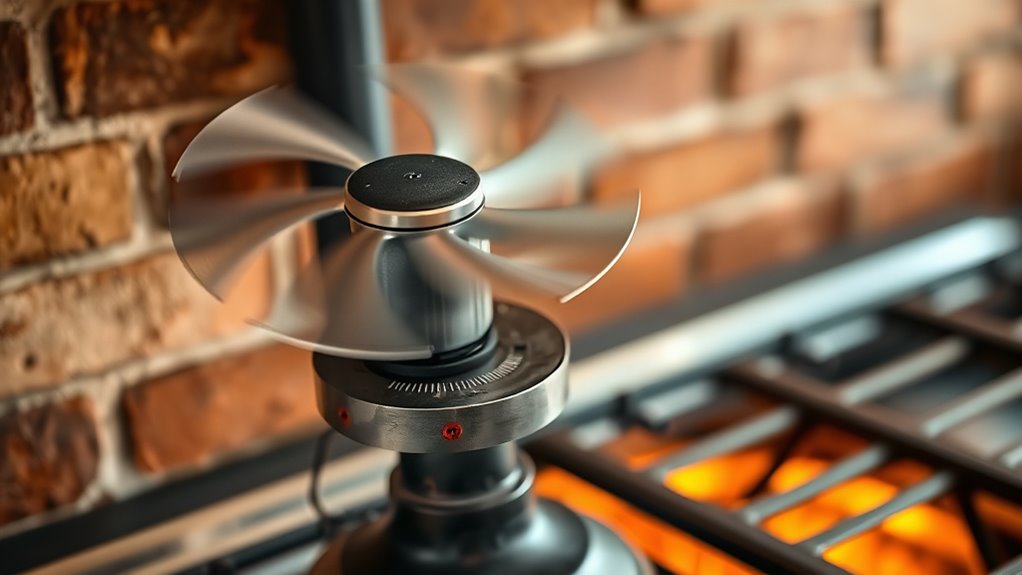
Stove fans convert heat into electricity through thermoelectric modules that exploit the temperature difference between the hot stove surface and the cooler room air. When the base of the stove fan heats up from contact with the stove, it creates a thermal gradient across the thermoelectric module. This temperature difference drives electricity generation by converting heat energy directly into electrical power. The thermoelectric module harnesses this thermal gradient to produce a small electrical current, which then powers the built-in motor of the stove fan. As a result, the fan blades turn to circulate warm air throughout your room. The process is silent, relies solely on heat energy, and doesn’t need external power sources or batteries, making stove fans an efficient way to distribute heat. Additionally, the design often incorporates Bluetooth or other wireless technologies to improve user control and monitoring, although these features are not essential for the core heat-to-electricity conversion process. Modern thermoelectric materials used in these modules enhance efficiency, allowing more effective conversion of heat into usable electrical energy. This innovation is part of a broader effort to develop energy-efficient solutions that maximize resource use and reduce reliance on external power sources. Incorporating sustainable design principles can further improve the environmental impact of these devices, promoting eco-friendly heating solutions.
The Process of Heat Absorption and Temperature Differential
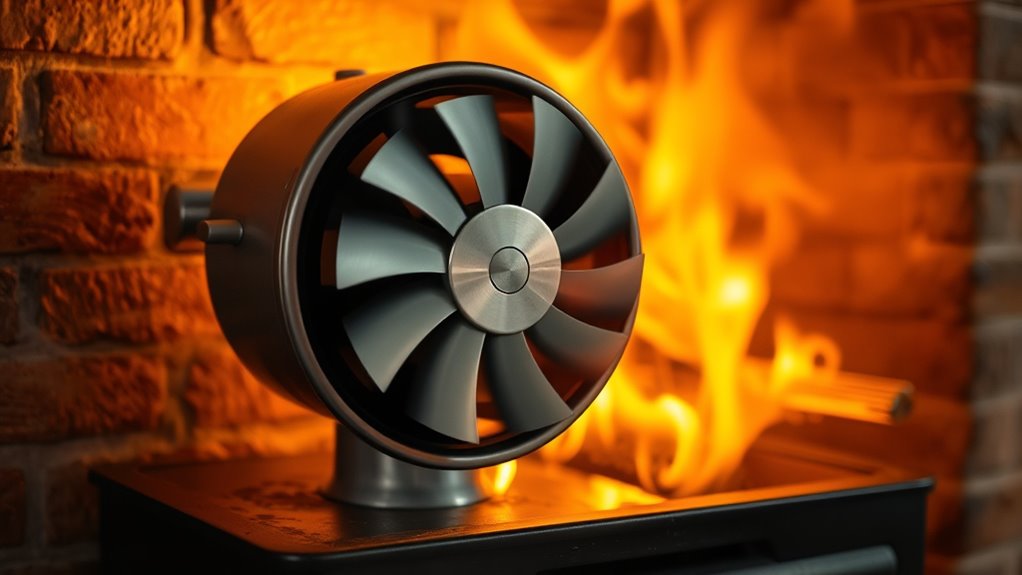
When the stove heats up, heat flows directly into the base of the stove fan, which is designed to absorb it efficiently. This process creates a temperature difference between the hot side (touching the stove surface) and the cold side (exposed to room air). The thermoelectric module inside the fan detects this gradient, converting it into electrical energy. This energy powers the fan’s motor, causing blades to spin and circulate warm air. Proper contact with the stove surface and a sufficient operating temperature are vital for effective heat absorption. The table below highlights key aspects of this process:
| Aspect | Explanation |
|---|---|
| Heat absorption | Achieved through contact with stove surface |
| Temperature difference | Drives thermoelectric conversion |
| Hot side | In contact with stove surface |
| Cold side | Exposed to room air |
| Electrical energy | Powers the fan motor |
Additionally, maintaining the correct heat transfer conditions ensures optimal performance of the stove fan.
How Thermoelectric Modules Power the Fan
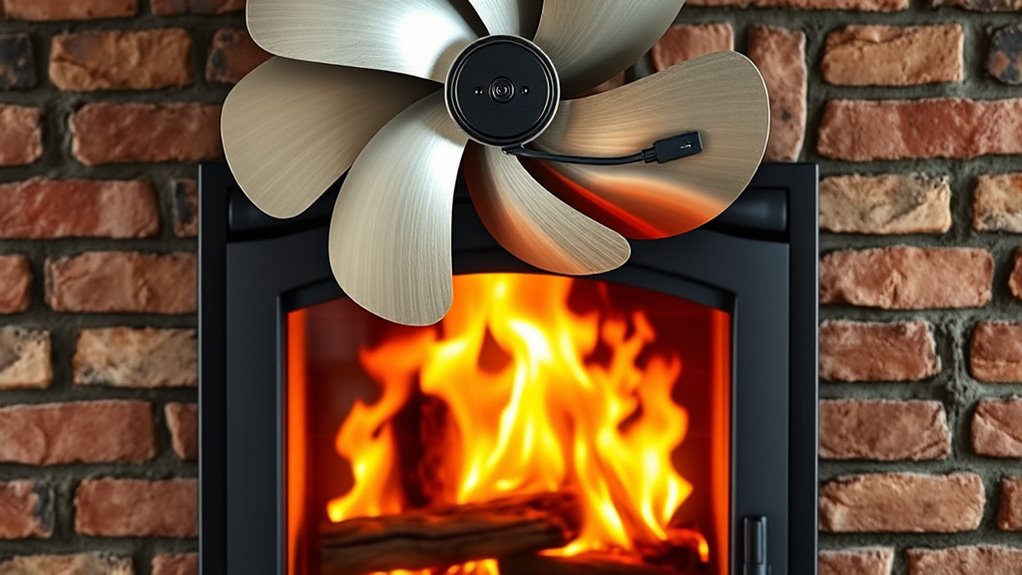
Thermoelectric modules inside stove fans generate electricity by harnessing the temperature difference between their hot and cold sides. When the hot side contacts the stove surface and the cold side faces cooler room air, a temperature gradient develops. This difference causes electron flow within the module, producing a small electrical current. That current powers the fan motor, which then circulates warm air for efficient heat distribution. Safety precautions should be taken to ensure the longevity of the device and proper operation. The heat from the stove creates the temperature difference needed for power generation. Electron flow converts heat into electricity within the thermoelectric module. The small electrical current energizes the fan motor to turn the blades. This process ensures consistent heat circulation without external power sources. Additionally, understanding AI in Education can inspire innovations in smart heating systems that optimize energy use. Incorporating thermoelectric technology can further improve energy efficiency and sustainability of such devices. Furthermore, advancements in energy conversion efficiency may lead to more powerful and reliable thermoelectric stove fans in the future. Exploring innovative materials used in thermoelectric modules can also enhance their performance and durability over time.
The Impact of Stove Fans on Heat Circulation
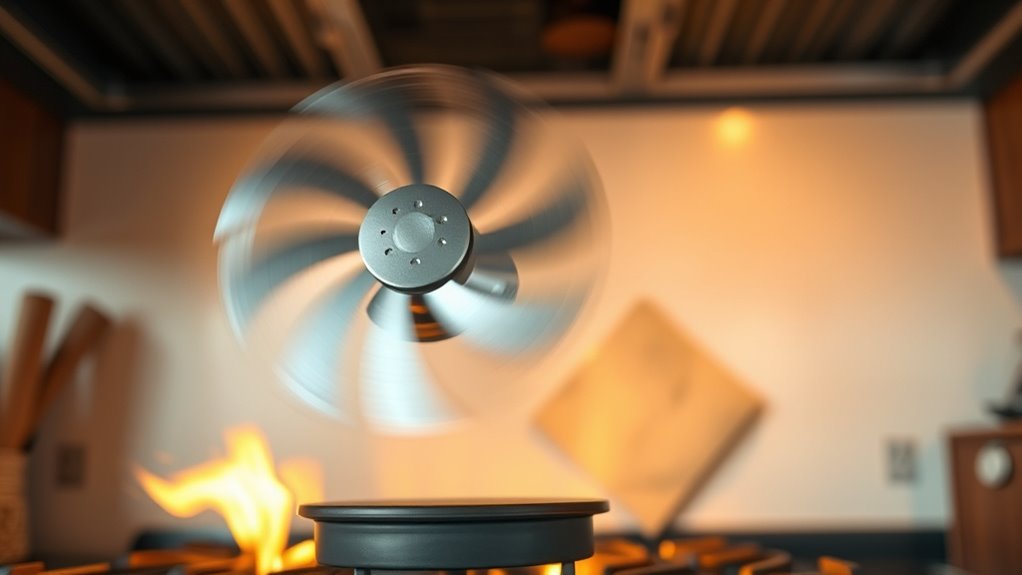
Stove fans improve heat circulation by actively moving warm air into the room, reducing cold spots. As the blades spin, they distribute heat more evenly, helping every corner warm up faster. This increased airflow boosts comfort and efficiency without using more fuel. Additionally, the use of high smoke point oils can enhance the overall heat distribution process when cooking on the stove. Proper airflow management is essential for maximizing heat transfer and maintaining consistent temperatures throughout your space. Incorporating crochet techniques into your heating setup can also promote better air movement and distribution. For example, tuning modifications such as performance exhaust systems can further optimize heat output and airflow in certain appliances or setups, supporting the recognition of angel number soulmate signs in your environment.
Enhanced Airflow Dynamics
Stove fans actively enhance heat circulation by increasing horizontal airflow, ensuring warm air is dispersed more evenly throughout the room. This improved airflow promotes better heat transfer by creating a convective current that moves heated air away from the stove. As a result, temperature distribution becomes more uniform, reducing hot spots near the stove and cold areas farther away. The increased airflow speeds up heat circulation, helping the room warm up faster than relying on natural convection alone. Properly positioned stove fans can boost heat efficiency without extra energy, making your heating more effective. Regional regulations may influence the optimal use of stove fans to ensure safety and efficiency. Additionally, integrating remote control options can help monitor and optimize fan performance conveniently. Incorporating digital literacy strategies can also educate homeowners on safe and effective usage of smart heating devices. Understanding heat distribution principles can further optimize the placement and operation of stove fans for maximum benefit. Moreover, utilizing organic techniques in related heating or energy-efficient practices can support sustainable and cost-effective home heating solutions.
Even Temperature Distribution
Enhanced airflow from stove fans plays a key role in achieving even temperature distribution across your living space. The fan blades boost airflow, moving warm air horizontally and reducing temperature gradients. This disperses heat evenly, preventing hot spots near the stove and cold areas farther away. As a result, heat circulation becomes more efficient, promoting uniform warmth throughout the room. Proper placement and operation of stove fans optimize heat distribution and contribute to energy efficiency. Stove fans are designed to operate safely and quietly, ensuring they do not disrupt your environment. Additionally, understanding ventilation principles can help maximize their effectiveness and safety. Properly circulating warm air can also help reduce hot spots, leading to a more comfortable and consistent indoor climate. Maintaining awareness of health risks and allergies related to seed consumption can help ensure safety in your environment.
Enhancing Room Comfort and Energy Efficiency
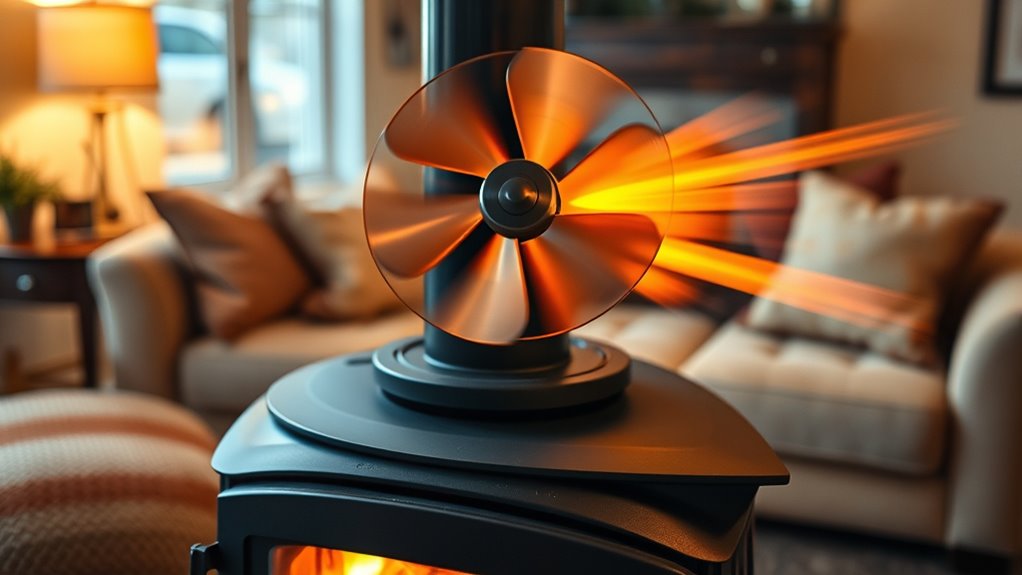
By improving how heat circulates in a room, stove fans considerably boost comfort and energy efficiency. They evenly distribute warm air, reducing cold spots and maintaining consistent temperature. This efficient heat circulation allows you to achieve desired warmth with lower stove settings, saving energy. Using stove fans also minimizes the need for extra heating devices, making your home more energy-efficient. Additionally, automatic operation adjusts fan speed based on stove temperature, optimizing heat flow without manual effort. As a result, you enjoy a more comfortable environment while reducing fuel consumption. Proper heat distribution enhances overall heating performance and helps you control room temperature more effectively. Digital literacy programs encourage playful communication, which can further improve engagement with stove fan technology and promote better understanding of energy-saving practices. With stove fans, you get better heat output, increased comfort, and greater energy savings—all in one solution.
Practical Considerations for Selecting and Using Stove Fans
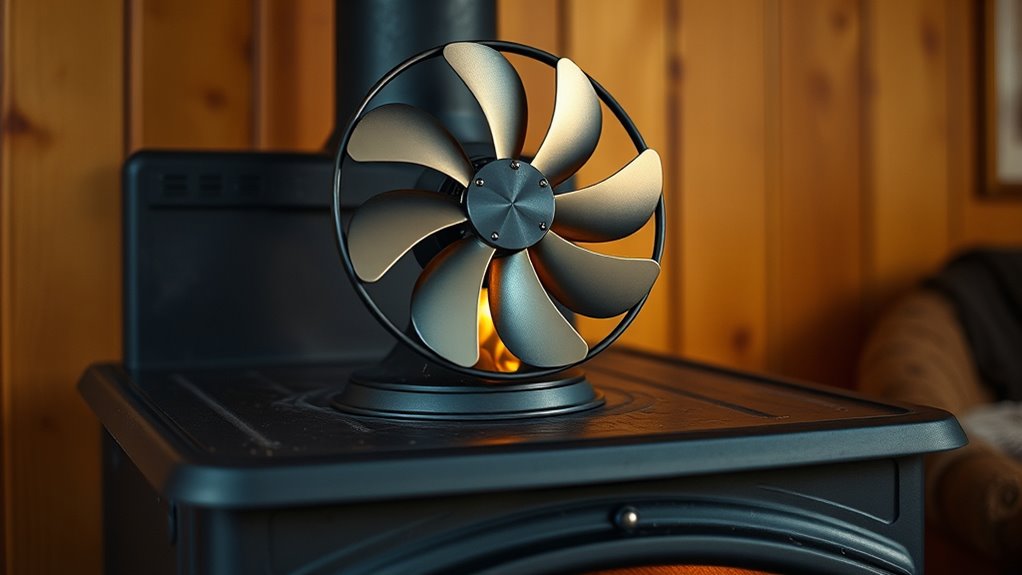
To get the most out of your stove fan, focus on proper placement and managing heat levels. Position the fan on a stable, flat surface with good airflow, avoiding contact with flames or water. Keep an eye on the stove’s temperature and follow the manufacturer’s instructions to guarantee safe and efficient operation.
Proper Placement Techniques
Proper placement of your stove fan is essential for maximizing heat circulation and ensuring safety. Correct stove placement ensures the fan effectively transfers heat and promotes airflow enhancement. Position the fan on a flat, stable surface near the back or side of the stove, with direct contact on the stove surface for proper installation and efficient heat transfer. Make sure the fan blades are clean to maintain smooth airflow and reduce noise. Keep the fan away from combustible materials and airflow obstructions to prevent hazards and enhance heat circulation. Before placing the fan, verify that the stove surface temperature falls within its specified temperature range. This careful placement ensures stove safety and peak performance in distributing warmth throughout your space.
Managing Heat and Burn Rate
Placing your stove fan correctly can help optimize heat circulation without unintentionally increasing fuel consumption. Stove fans enhance heat distribution by improving heat transfer across the stove surface, but they can also cause the fire to burn faster if you open the stove’s air intake to increase airflow. This may raise the burn rate and fuel consumption. However, properly managing stove temperature control and fan operation can prevent this. Turning the thermostat down doesn’t always open the air intake, allowing efficient burning without extra fuel use. Using a stove fan at high burn rates can boost heat transfer, but it may lead to faster wood consumption if not carefully managed. Balance fan operation with your fire’s intensity to maximize heat and conserve fuel.
Common Misconceptions About Stove Fans and Efficiency

Many people believe that stove fans somehow make their stoves more efficient by burning less fuel or generating more heat, but this isn’t accurate. Stove fans mainly improve heat circulation and redistribution, not stove efficiency itself. They don’t lower fuel consumption; instead, they move existing heat more effectively throughout the room. Some misconceptions suggest that stove fans generate additional heat, but they only facilitate heat movement already produced by the stove. Proper placement and operation are essential; if used incorrectly, they won’t improve heat distribution.
Stove fans improve heat distribution but do not increase stove efficiency or reduce fuel use.
- Stove fans don’t reduce fuel consumption; they only enhance heat redistribution.
- They don’t generate extra heat, just move existing warmth.
- Efficiency depends on proper placement, not the fan itself.
- Improved heat circulation increases comfort but doesn’t affect stove efficiency.
Frequently Asked Questions
What Is the Point of a Stove Fan?
You’re wondering what a stove fan’s point is. Fundamentally, it helps you feel warmer faster by circulating heat evenly across your room. It uses the heat from your stove to power itself, so there’s no need for batteries or electricity. This means you get more comfortable, consistent warmth without extra energy costs. In short, it makes your stove more effective at spreading heat, improving your overall comfort.
Do Stove Fans Make Any Difference?
You might wonder if stove fans really make a difference. Ironically, they don’t boost your stove’s fuel efficiency or burn rate, yet they do a great job at spreading warmth. You’ll notice your room warms up faster and more evenly, preventing cold spots. So, even if they seem like small gadgets, they actively improve comfort by making your space feel warmer, quicker, and cozier—without any extra effort from you.
Do Heat-Powered Stove Fans Really Work?
You might wonder if heat-powered stove fans really work. The answer is yes. They convert heat from your stove into electricity, which powers the fan blades to circulate warm air across your room. This process effectively reduces cold spots and makes the space feel warmer. Multiple studies and user experiences back this up, showing that these fans reliably enhance heat distribution without needing external power sources.
Is It Worth Having Two Stove Fans?
Thinking about whether two stove fans are worth it is like trying to hit two birds with one stone. If you have a large or tricky space, adding a second fan can really boost heat circulation, making your room more comfortable. It can help balance airflow and eliminate cold spots. Just keep in mind, it might cost more upfront and require careful placement to avoid airflow clashes.
Conclusion
While some might think stove fans are just optional gadgets, they actually boost heat circulation and comfort, saving you energy. You might worry they’re complicated or expensive, but many models are simple to install and cost-effective. By enhancing heat distribution, stove fans help you enjoy warmer rooms without cranking up your thermostat, making your space more comfortable and efficient. Don’t overlook their benefits—adding a stove fan could be a smart upgrade for your home.

